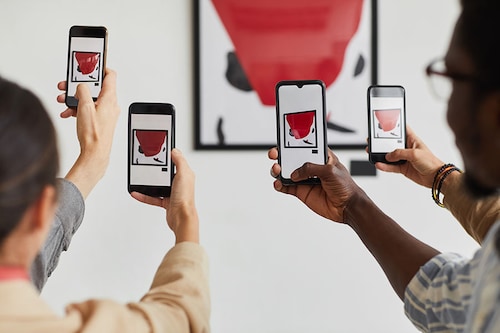Museums are increasingly bowing to the power of the selfie
Selfie bans are gradually being reviewed to meet the expectations of an increasingly connected audience


There are few places more conducive to photography than museums. But some art establishments take a dim view of visitors snapping some of their prize pieces. However, these bans are gradually being reviewed to meet the expectations of an increasingly connected audience.
This change of heart is reflected in the Museo Reina Sofàa"s new policy on "Guernica" (1937), by Pablo Picasso. For decades, the Madrid museum had forbidden its visitors from taking photos of the Spanish artist"s gigantic anti-war painting. This precautionary measure was intended to protect the painting from camera flashes, but also to avoid leading to a mass of people armed with smartphones and selfie poles gathering in front of the artwork.
Such crowds are not without danger for visitors, but above all for the works they come to admire. For example, "La romeràa de los cornudo" (1933) by Alberto Sà¡nchez was damaged in June 2022 by a tourist trying to pose in front of this Reina Sofàa treasure. The artwork was partially torn, although experts from the museum"s restoration department considered the damage to be minor.
But, at a time when more and more museums are relying on social media to boost attendance, they can no longer afford to forbid visitors from photographing the works of their choice—including "Guernica." That"s why the Reina Sofàa museum is now allowing photos to be taken of, or in front of, the painting by Picasso, a measure effective as of September 1, according to Euronews. However, the museum continues to prohibit photography with flashes, tripods, selfie poles and "any other type of camera stand," according to the museum"s regulations.
For Manuel Segade, director of the Museo Reina Sofàa, this new policy concerning "Guernica" seeks to exploit the photogenic potential of one of the world"s best-known paintings. "[We] are constantly mediated by cameras, when we go to a concert, when we go to any cultural event. We believe that it doesn’t make sense that ‘Guernica’ doesn’t have the same iconic character it deserves," he told Euronews. The initiative also puts an end to years of controversy surrounding the Madrid museum"s restrictive policy. In the past, the Reina Sofàa has come under heavy criticism after celebrities such as Mick Jagger and Pierce Brosnan photographed themselves with Picasso"s masterpiece. A privilege then denied to other visitors.
The Museo Reina Sofàa is not the only art institution worldwide to review its rules surrounding photography. Most international museums have become more permissive in recent years, in order to improve their brand image and maintain a link with their audience. Some even encourage their visitors to take out their smartphones by designing "Instagrammable" exhibitions, like those at the Atelier des Lumià¨res in Paris or the Museum of Selfies in Los Angeles. The latter has been so successful since it opened in 2018, that it has since spawned outposts all over the world. Indeed, it seems that, in the museum world, the selfie is king.
First Published: Sep 14, 2023, 15:07
Subscribe Now